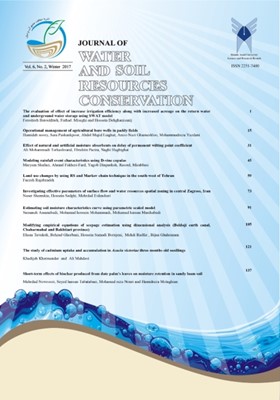Investigating effective parameters of surface flow and water resources spatial zoning in central Zagross, Iran
Subject Areas : Farm water management with the aim of improving irrigation management indicatorsNasser Shamskia 1 * , Hossein Sedghi 2 , Mehrdad Esfandyari 3
1 - عضو هیات علمی - دانشگاه آزاد اسلامی
2 - استاد/دانشگاه آزاد اسلامی
3 - استادیار
Keywords: water resources zoning, multi-variable regression, rainfall-runoff, hydrological parameters,
Abstract :
Various parameters, such as rainfall, region height, evaporation rate, temperature, climate factors, drainage, topography and geology of the basin effect runoff in watersheds. Due to the interrelation of some of the mentioned parameters, their quality and effect on runoff may be different for each region. This paper presents a statistic assessment of the parameters that are effective on runoff and spatial zoning of surface water resources in central Zagross, west of Iran. The results showed a relationship between logarithmic distribution of surface runoff, and temperature and height variables with a 0.795 - 0.851 R2 coefficient of determination, applying statistical analysis and multi-variable regression method for the parameters. Considering 80 selected stations of the studying area with a correlation of 0.923, the runoff distribution in the form of discharge logarithm related to rain logarithm and height variable with confidence level of 95% showed meaningful and acceptable relation .The zoning plan was prepared through ArcGIS software on the basis of weighting effect index of each variable. The analysis of factors which affect runoff formation, and also analysis of the effect of the mentioned variables on preparing zoning plan showed tremendous movement of potentially appropriate water resources regions from south towards north and east of the studying area. Furthermore, there was approximate correspondence between hydrological parameters and determination of suitable water resources location, and statistic multi-variable regression analysis, logistic and weighting index determination of variables methods.
ابریشم چی، ا.، تجریشی، م.، چهره نگار، ب. 1384. مدلهای استوکاستیک منطقهای جریان سالانه حوزههای آبریز غرب ایران. مجله تحقیقات منابع آب ایران، 1 (1): 48-57.
جلال کمالی، ن.، صدقی،ح. 1387. مدلسازی اطلاعات محور سببی فرآیند پویای بارش-رواناب در حوضه کارون علیا. مجله دانش نوین کشاورزی، 4 (1): 27-40.
رستمی، ر.، صدقی،ح.، معتمدی، ع. 1388. تحلیل سیلاب حوضهی دز. مجله مهندسی آب، 2 (1): 61-70.
صدقی، ح. 1371. ارزیابی و برآورد ابعاد حداکثر بارش سیلاب محتمل حوضه آبریز کارون در پل شالو به عنوان معیار طراحی سد کارون 3 ، شرکت توسعه منابع آب و نیروی ایران، 200 ص.
قنبرپور، م، ر. 1386. بررسی الگوهای استوکاستیک رواناب در مقیاسهای زمانی و مکانی مختلف در برخی حوضههای آبریز جنوب غرب ایران. مجله تحقیقات منابع آب ایران، 3 (1): 36-44.
Abi-Zeid, I., and Bobée, B. 2004. The stochastic modeling of low flows by the alternating point processes approach: methodology and application. Journal of hydrology, 285(1): 41-61.
Ball, E. J., and Luk, K.c. 1998. Modeling spatial variability of rainfall over a catchment, Journal of Hydrological Engineering , 3(2): 122-130.
Chow, V. T., Maidment, D. R. and Mays, L.W. 1988. Applied Hydrology, New York, Mc Graw Hill Pub. p. 572
Durrans, S. R., and Pitt, R. 2004. Maximum likelihood estimates for coarsely resolved precipitation Data, Journal of Hydrologic Engineering, 9:13-27.
Fervert, D. K., Cowan, M. S. and Lane,W. L. 1989. Use of stochastic hydrology in reservoir Operation. Journal of Irrigation and Drainage Engineering, ASCE, 115(3): 334-343.
Gabellani, S., Boni, G., Ferraris, L., Von Hardenberg, J., and Provenzale, A. 2007. Propagation of uncertainty from rainfall to runoff: A case study with a stochastic rainfall generator. Advances in water resources, 30(10): 2061-2071
Karvonen T., Koivusalo H., Jauhiainen M., Palko J. and Weppling K. 1999. A hydrological model for predicting runoff from different land use areas, Journal of Hydrology, 217: 253-265.
Mc.Cuen R. H. and Snyder, W. M. 1986. Hydrologic modeling: Statistical methods and applications, Englewood and Cliffs, N.J.; Prentice- H all Inc, 569 pp.
Mc.Cuen, R. H., and R. E. Beighley 2003. Seasonal flow frequency analysis, Journal of Hydrology, 279:.43-56.
Najafi M. R., 2003. Watershed modeling of rainfall excess transformation into runoff, journal of Hydrology, 270(.3-4): 273-281.
Sajikumar N. and Thandaveswara, P. S. 1999. A non-linear rainfall- runoff model using an artificial neural network; Journal of Hydrology, 216: 32-35.
Sanso, B., and Guenni, L. 1999. A stochastic model for tropical rainfall at a single location. Journal of hydrology, 214(1), 64-73.
Singh V. P., 1982. Applied modeling in catchments hydrology, Littleton, Colo; Water Resources Publication.
Singh, V. P. 1988. Hydrologic systems. v. 1. Rainfall-runoff modeling. Prentice Hall PTR, 960 pages.
Triola, M. F. 2008. Elementary statistics with multimedia study guide. Pearson Addison Wesley. 912 pp.
Viglione A, . Parajka, J. Rogger, J. L. Salinas, G. Laaha, Sivapalan, M. and Bloschl, G. 2013. Comparative assessment of predictions in ungagged basins-part 3: Runoff signatures in Austria; Hydrological Earth System Sciences; 17: 2263-2279.
Vogel R. M., and Stedinger, J. R., 1988. The value of stochastic stream flow models in Over year Reservoir Design Applications, Water reservoir Research. 24(9): 1483- 1490
Vogel R. M., and Sankarasubramanian, A. 2000. Spatial scaling properties of annual stream flow in the United States , Hydrological Sciences Journal,45(3): 465-476.
Viessman Jr, W., and Lewis, G. L. 1996. Introduction to Hydrology, HarperCollins College Publishers. New York. 760 PP.
Wright, D. B., Smith, J. A., and Baeck, M. L. 2014. Flood frequency analysis using radar rainfall fields and stochastic storm transposition. Water Resources Research, 50(2): 1592-1615.

